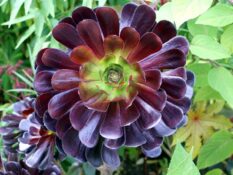Propagate | Soil | Light | Water | Temperature | Humidity | Potting | Pruning | Fertilize | Pest Control | FAQs
Alocasia stingray is a tropical perennial plant native to South and Southeast Asia, as far as Australia. It has large arrow-shaped leaves with prominent veins often striped in shades of green and grayish-green. The plant can grow up to two feet tall and broad. Alocasia stingray will produce yellow or white flowers in the spring or summer, but it rarely blooms indoors.
This care guide is intended to answer many of the questions gardeners may have when it comes to caring for Alocasia stingray plants. We'll cover topics such as sunlight and water requirements, temperature ranges, soil types and fertilizer, pests and diseases, and propagation. With the right care, you can grow a beautiful Alocasia stingray plant in your garden or home that will last for years.
Do Alocasia stingray flower? What color is the Alocasia stingray flower?
Yes, the Alocasia stingray can produce flowers. The flower color is yellow to white, depending on the variety of the plant. However, flowering indoors is quite rare and often not seen at all.
When to plant Alocasia stingray plant?
When planting Alocasia stingray plants, it's best to wait until after all danger of frost has passed. Plant your Alocasia stingray in a warm, sheltered spot with plenty of light. If you're growing it indoors or in a container, ensure plenty of drainages.
Alocasia stingray soil requirements: What is the best soil for the Alocasia stingray plants?
The best soil for Alocasia stingray plants should be fertile and well-drained. A mixture of compost, perlite, and peat moss is ideal. The pH of the soil should be slightly acidic to neutral, around 6.0 to 7.0.
Adding amendments and enhancers can improve the quality of your soil and help ensure a healthy Alocasia stingray plant. For example, adding a slow-release fertilizer to the topsoil can provide essential nutrients. You can also incorporate aged manure or compost into the soil to add organic matter and improve drainage.
Alocasia stingray light requirements: How much light does the Alocasia stingray plant need?
Alocasia stingray plants do best in bright, indirect sunlight. If you're growing your Alocasia stingray indoors or in the shade, position it near a window that receives plenty of indirect light. Avoid placing the plant in direct sunlight, as this can cause sunburn or scorching of the leaves.
Plant grow light can also be used to supplement natural light. A combination of cool and warm fluorescent lights can provide enough illumination for the plant to thrive.
Alocasia stingray water requirements: How often to water the Alocasia stingray plant?
Alocasia stingray plants should be kept evenly moist but not soggy. The best way to determine if a plant needs water is to stick your finger into the soil. If it feels dry, it's time to water. Allow the top layer of soil to dry out between waterings.
Overwatering can lead to root rot, so it's important not to overwater your Alocasia stingray. Ensure the pot has adequate drainage, and use an unglazed terra-cotta pot to prevent water from accumulating in the bottom of the pot.
An irrigation system can also be useful to keep your Alocasia stingray plant's soil consistently moist and provide the plants with just the right amount of water.
Alocasia stingray temperature range: What temperature can Alocasia stingray tolerate?
Alocasia stingray plants prefer temperatures between 68-85°F (20-29°C). Keep your plant away from drafty windows, heaters, or air conditioning vents, as they can cause temperatures to fluctuate too much. When night temperature drops below 55°F (13°C), move the plant indoors or undercover.
To protect plants during bad weather, You can use a greenhouse, cold frame, and plant protective covers to protect them from the elements.
Alocasia stingray humidity: Do Alocasia stingray like humidity?
Yes, Alocasia stingray plants prefer humid conditions. A humidifier can help maintain the ideal humidity if you're growing the plant indoors.
Alternatively, you can mist the plant using a spray bottle of room-temperature water. You could also group your plants to increase humidity or use a pebble tray with water.
To maintain the humidity of plants around your Alocasia stingray, use a humidifier or place the plant near a water feature.
Alocasia stingray plant propagation: How to propagate Alocasia stingray plant?
Several methods of propagating plants include division, stem cuttings, air-layering, and leaf cuttings.
Propagate Alocasia stingray plant from stem cutting
Alocasia stingray is easily propagated from stem cuttings. Take a cutting from the main stem with three or more leaves and remove any flowers or buds. Plant the cutting in potting mix and cover it with a plastic bag to retain moisture.
Place the plant in bright, indirect sunlight and keep the soil moist. After a few weeks, the cutting should have been rooted and can be transferred to its permanent location.
Propagate Alocasia stingray from rhizomes
Alocasia stingray is also easily propagated from rhizomes. Take a healthy rhizome and cut it into several pieces. Plant the pieces in a moist potting mix and cover them with a plastic bag to retain moisture.
Place the plant in bright, indirect sunlight and keep the soil moist. After a few weeks, the cuttings should have been rooted and can be transferred to their permanent location.
Propagating Alocasia stingray plant by air layering
Alocasia stingray can also be propagated by air layering. To do this, cut a slit in the stem and cover it with damp sphagnum moss. Place a plastic bag over the moss to retain moisture and tie it in place.
After a few weeks, new roots should appear at the cut site. Cut off the rooted stem and plant it in potting mix. Place the plant in bright, indirect sunlight and keep the soil moist.
Propagating Alocasia stingray plant by division
Alocasia stingray can also be propagated by division. Gently dig up the plant and separate the rhizomes, taking care not to damage them. Plant each piece in potting mix and cover with a plastic bag to retain moisture.
Place the plant in bright, indirect sunlight and keep the soil moist. After a few weeks, the divisions should have rooted and can be transferred to their permanent location.
Potting Alocasia stingray plant
Alocasia stingray plants should be planted in a well-draining potting mix. A mixture of peat moss, compost, and perlite works well.
Fill a pot with the potting mix and create a large hole for the Alocasia stingray's root system. Gently place the plant in the hole and backfill it with potting mix. Firmly press down on the soil to make sure it's well-compacted.
Water the Alocasia stingray once a week, allowing the soil to dry out between waterings. Place the plant in bright, indirect sunlight and fertilize it every two weeks during the growing season.
It is important to select the correct pot size or container for your Alocasia stingray. If the pot is too small, the plant may become root-bound and not have enough room to grow.
How to prune Alocasia stingray plant?
Pruning is important for Alocasia stingray plants as it helps to promote healthy growth and remove any damaged or diseased foliage. To prune an Alocasia stingray plant, cut away any dead or diseased leaves with a pair of sharp scissors.
Cut away any overgrown foliage and trim back any long stems. This will encourage new growth and help the plant to stay healthy.
After pruning, be sure to fertilize the plant to ensure it has all the nutrients it needs.
How to fertilize Alocasia stingray plant?
Fertilizing your Alocasia stingray is important for healthy growth. To fertilize the plant, use a balanced liquid fertilizer every two weeks during the growing season.
Mix the fertilizer with water according to package directions and apply it to the soil around the Alocasia stingray plant. Be sure not to apply too much fertilizer, which can burn the plant's roots.
Fertilize the plant once in the spring and twice in the summer, then once more in the fall before the plant goes dormant.
Choose a high-quality fertilizer with a balanced NPK (nitrogen, phosphorus, and potassium) ratio to fertilize your Alocasia stingray. Some of the plants also benefit by adding appropriate soil amendments.
Common Alocasia stingray diseases and how to manage Alocasia stingray disease?
Alocasia stingray plant is prone to a few common pests and diseases, including:
• Rust: a fungal disease that causes yellow spots on the leaves and stems. This can be managed by removing any affected foliage and applying a fungicide to the plant.
• Aphids: these insects feed on plant sap and can be managed by spraying them with insecticidal soap and water.
• Root rot: caused by excessive moisture and poor drainage; root rot can be prevented by avoiding over-watering and ensuring the plant is planted in well-draining soil. If root rot occurs, it can be managed by removing any affected areas and applying a fungicide.
• Spider mites: These tiny insects feed on plant sap and can be managed by spraying them with insecticidal soap and water.
Following proper care instructions, Alocasia stingray plants can be kept healthy and free from pests and diseases. In case of an outbreak, Use good quality insecticides and fungicides to manage diseases and pests. Monitor the plant regularly for any signs of disease or pests and take timely action to prevent its spread.
Ten reasons to grow Alocasia stingray
1. Versatile and Attractive: Alocasia stingray plants are versatile and attractive, making them a great addition to any home or garden.
2. Easy to Care: Alocasia stingray plants are easy to care for and require minimal maintenance. They can thrive in almost any condition with the right soil, water, light, and fertilization.
3. Fast Growing: Alocasia stingray plants are fast-growing and can reach maturity in just a few months when given proper care.
4. Low Maintenance: Alocasia stingray plants don't require much pruning or other maintenance once established and can be left alone for long periods without ill effects on their health.
5. Elegant Design: Alocasia stingray plants have an elegant and modern design that can fit into almost any interior or exterior décor.
6. Easy to Propagate: Alocasia stingray plants are easy to propagate by division, meaning you can easily grow new plants from old ones.
7. Good For Air Quality: Alocasia stingray plants help to improve air quality by releasing oxygen into the atmosphere.
8. Great Conversation Piece: Alocasia stingray plants are great conversation pieces, come in various shapes and sizes, and their foliage is unique and eye-catching.
9. Low Allergy Risk: These plants don't produce pollen or other allergens, making them a great choice for those with allergies.
10. Long-Lasting: With proper care, Alocasia stingray plants can last a long time, outliving many other types of plants.
Takeaway on how to grow and care for Alocasia Stingray
Alocasia stingray is a unique and beautiful plant that can be an eye-catching addition to any home or garden. It's great for air quality, low maintenance, and easy to propagate. To ensure your Alocasia stingray plants thrive, ensure you provide them with well-draining soil and the proper water, light, and fertilization. Monitor them regularly for signs of pests or disease and take appropriate action when needed. With the right care and attention, your Alocasia stingray will continue bringing life and beauty into your space for many years!
Explore our plant grow and care guides collection if you want to add more plants to your garden.
If you're new to gardening or a seasoned pro, join our supportive AgFunnel community of gardeners. Share a picture of your garden and receive support from fellow plant lovers. Happy gardening.
FAQs
What is Alocasia stingray?
Alocasia stingray is an exotic and beautiful plant with unique foliage. It's easy to care for and requires minimal maintenance, making it a great choice for novice and experienced gardeners. Alocasia stingray plants can help improve air quality by releasing oxygen into the atmosphere and can last for many years with proper care.
Where to put Alocasia stingray?
Alocasia stingray plants are best suited for bright, indirect light. They can thrive near a window or in the filtered sun outdoors. When placed in direct sunlight, their foliage may become sunburned. Ensure the plant has access to plenty of fresh air, and avoid positioning it near air conditioning or heating vents.
How often should Alocasia stingray be watered?
Alocasia stingray prefers moist soil and should be watered when the top inch of soil is dry. Allow the water to drain fully before watering again. To avoid overwatering, using a soil moisture meter or your finger to test when the plant needs water is best. Ensuring the soil is well-draining is important as standing water can cause root rot.
How to get Alocasia stingray to bloom?
Alocasia stingray plants don't typically produce blooms, but with the right care and attention, it is possible to get them to bloom. Provide your plant with plenty of bright, indirect light, keep the soil moist but not soggy, and fertilize regularly during the growing season. If the plant is getting enough light, consider adding a bloom booster fertilizer to help encourage blooms.
Does Alocasia stingray plant like sun or shade?
Alocasia stingray plants prefer bright, indirect light and can tolerate up to 6 hours of direct sun daily. When placed in direct sunlight, their foliage may become sunburned. Avoid positioning the plant near air conditioning or heating vents, and ensure it has access to plenty of fresh air.
Is the Alocasia stingray plant annual or perennial?
Alocasia stingray plants are perennial, meaning they can last for many years with proper care. To ensure your Alocasia stingray plant thrives, ensure you provide it with well-draining soil and the proper amount of water, light, and fertilization. Monitor them regularly for signs of pests or disease and take appropriate action when needed. With the right care and attention, your Alocasia stingray will continue bringing life and beauty into your space for many years!
Does the Alocasia stingray plant come back every year?
Yes, Alocasia stingray plants can come back every year with proper care. Provide your plant with well-draining soil and the proper amount of water, light, and fertilization. Monitor them regularly for signs of pests or disease and take appropriate action when needed. With the right care and attention, your Alocasia stingray will continue bringing life and beauty into your space for many years!
Are Alocasia stingray plants toxic to cats?
Yes, Alocasia stingray plants are toxic to cats and should not be kept in homes with them. All parts of the plant contain calcium oxalates, which can irritate the skin and mouth if ingested. If your cat is exposed to the plant, seek veterinary care immediately.
Are Alocasia stingray plants toxic to dogs?
Yes, Alocasia stingray plants are toxic to dogs and should not be kept in homes with them. All parts of the plant contain calcium oxalates, which can irritate the skin and mouth if ingested. If your dog is exposed to the plant, seek veterinary care immediately.
Are Alocasia stingray plants toxic to pets?
Yes, Alocasia stingray plants are toxic to all pets and should not be kept in homes with them. All parts of the plant contain calcium oxalates, which can irritate the skin and mouth if ingested. If your pet is exposed to the plant, seek veterinary care immediately.
How cold can Alocasia stingray plants tolerate?
Alocasia stingray plants are tropical plants that can't tolerate cold temperatures. They should be kept in temperatures above 55°F (13°C) and protected from drafts, cold winds, and frost. If your plant is exposed to temperatures below this, seek immediate help from a professional.
How often to water the Alocasia stingray plant?
Alocasia stingray plants should be watered regularly, allowing the soil to dry completely between waterings. During the growing season, your plant may need to be watered every other day, while it should only be watered once a week during the winter. If you need help determining how often to water your plant, stick your finger an inch into the soil and if it feels dry, it's time to water.
When to stop watering the Alocasia stingray plant?
You should stop watering your Alocasia stingray plant when the soil dries completely. This may be every other day during the growing season, while it should only be watered once a week during the winter months. If you're unsure when to stop watering your plant, stick your finger an inch into the soil, and if it feels dry, it's time to stop watering.
When to fertilize Alocasia stingray plant?
Your Alocasia stingray plant should be fertilized every two weeks during the growing season. Use a balanced liquid fertilizer. Apply it to the soil until it is completely soaked. During the winter months, you can reduce fertilization to once a month. Refrain from overfertilizing your plant, which can lead to burning and other damage.
Are the Care Techniques for Alocasia Silver Dragon Similar to Alocasia Stingray?
When it comes to growing Alocasia Silver Dragon plant, the care techniques are quite similar to those of Alocasia Stingray. Both plants require well-draining soil, bright indirect light, and high humidity to thrive. Regular watering and fertilizing during the growing season will help these stunning plants flourish.
Where to buy Alocasia stingray plant?
Alocasia stingray plants can be purchased from many garden centers and online retailers. When you buy your plant, inspect it for signs of pests or disease and ensure it is healthy before bringing it home. If you're buying online, research the seller before making a purchase.

How to master gardening? Download these essential home and gardening ebooks today!













